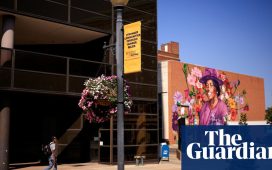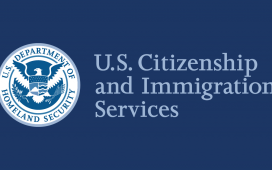On Tuesday, Joe Biden unveiled the most restrictive immigration policy of his presidency with an executive order enabling the mass rejection of asylum seekers at the US-Mexico border when crossings reach certain levels.
The order would allow the US government to temporarily shut down the border when the number of people seeking entry exceeds a daily threshold, empowering authorities to automatically block migrants from presenting their asylum cases. The policy, which would significantly erode the rights of asylum seekers, appears to be one of the harshest immigration crackdowns pushed by any modern Democrat and mirrors the Trump administration’s efforts to broadly limit entries en masse.
The announcement, five months before election day, comes as polls suggest immigration is a top concern of voters and Republicans have sought to attack the president on the issue as cities across the US face an increase in the number of people arriving. In recent years, there has been a sharp increase in migrants attempting to enter the US from the southern border, although officials have reported decreases since December. The US has seen similarly high levels of crossings in decades prior, but now the majority of people aren’t attempting to avoid capture and instead are presenting themselves to authorities in hopes of getting protection. Many request asylum, meant for those who have fled persecution based on their race, religion, nationality, social group or political opinion.
There are a wide range of complex forces driving the high rates of people turning up at the border, including escalating violence, poverty, natural disasters and political insecurity in their home countries, and few options to legally migrate to the US.
What’s clear is that the US immigration system, which hasn’t been updated in more than 30 years, is not built to process the volume of applications, leading to an extraordinary backlog in cases, forcing some asylum seekers to wait years for a resolution.
Democrats in Congress have for years tried to pass comprehensive immigration reforms, with Senate Republicans blocking bipartisan proposals.
The Guardian interviewed five asylum seekers – some with claims already approved and some who are still going through the process – about their journeys and the reality of the application process amid a broken system. The interviews have been translated and edited and condensed for clarity.
Alejandra Hernandez, 32, Guatemala: ‘The only lawyer I could find was on Facebook’
My dream is for a better life for my four daughters. I had no future in Guatemala. The father of my children caused me a lot of harm, abusing me and burning my skin. I had to leave. He had a gun, and I don’t think I would have survived. I was scared about the journey and scared I wouldn’t get asylum, because I know they send a lot of people back to Guatemala.
I came to California in 2018 with my nine-year-old daughter. The journey took about 30 days. We often didn’t have food. We were locked inside trucks. My daughter just wanted it to be over. We were held for four days in the CBP “ice boxes” when we arrived. We didn’t have good clothes or water.
In my first court hearing, the judge said I should have an attorney. CBP gives us a list of non-profits, but I called and they were all too busy. So I searched Facebook and the only lawyer who responded was a man who did not represent me well. He didn’t tell me there was a deadline to file separate petitions for my three daughters still in Guatemala. He just wanted me to give him more money.
My daughter and I got asylum in 2020. I thank God for the judge. I showed her my scars. She looked at my papers and understood I needed to be here. The Oakland school district connected me to [Immigrant Legal Defense (ILD)] attorneys last year, who are helping me with asylum for my other daughters. I get very emotional, but I try to just be hopeful. I wish people could understand the happiness we have when we’re told we can stay here and have a better life and contribute and be a part of society. We come because we’ve suffered violence. The most beautiful thing for me is to be able to tell the truth about what I’ve been through.
Andrés García, 30, El Salvador: ‘I just wanted to be myself and not get hurt’
I came out as gay when I was 17 years old. I come from a conservative Christian family, and my mom kicked me out. I was living on the streets for a year. I just wanted to be me and not get hurt in the process, but as a gay man in El Salvador, they look at you as a drug dealer, a rapist, everything bad. I wanted to prove to my family I could succeed, so I continued with studies and got a degree in public accounting. But I couldn’t get a job. I’m as gay as it gets – vocally and how I look – so I was always denied even though I had all the credentials. There was no place for me in El Salvador. The discrimination was in every corner – when you’re walking in the streets, on public transportation. I knew and saw people who were murdered for being gay. Gang members were targeting my community and got away with it. I knew my government would not protect me, I would never be able to love whoever I wanted to love, and I could be killed.
I crossed through Texas in November 2016 and lived without status for years. In 2022, police in Virginia handed me over to Immigration and Customs Enforcement to face deportation. I was in custody for nearly a year as I fought for asylum. It takes so long to get to see a judge. So many people just give up, even though we all have an international right to seek asylum. We deserve the opportunity to ask, but they make it so hard on us. I almost gave up, but I met good lawyers from Capital Area Immigrants’ Rights Coalition and decided I’m going to fight this until the end.
I was approved for asylum in July 2023. It has changed everything. I can work freely, get a driver’s license, go to school, pursue my goal of being an interior designer. I can go into a federal building or attend a protest without fear of arrest. I can come out from the shadows.
I wish lawmakers would understand we’re not here to hurt anybody or steal jobs. They are trying to dehumanize us, calling us animals. That’s not right and shouldn’t be allowed on social media or TV. We are not criminals. We’re hard-working people who are here to make this country prosper.
Flor Fernandez Alvarado, 30, Mexico: ‘I’ve been waiting 10 years’
I have been waiting for asylum for more than 10 years. I hope there’s something good at the end of this wait, but it’s been very difficult.
I grew up in Michoacán, Mexico. We didn’t have a lot of money, but we were happy. Then the cartel wanted to force my husband into their organization. He refused and we received death threats against me and my kids. In 2013, we had to flee. Our only option was to come here. My kids were six months and two years old.
When we arrived in San Diego, I felt really sad and wanted to return home. I didn’t want my children to face racism in the US. But I had to find my strength because we needed to save our lives. After we crossed, we began the asylum process.
Our case is still pending. [Editor’s note: her next court date is scheduled for 2026.] In that time, I’ve had to repeatedly renew my work permit; because there are often huge delays, I lose work. I live in Fresno, California, and work as a farmworker picking fruit. At times, I didn’t know how I was going to pay rent or for food, but I always try to save for a little bit. It’s very frustrating because there’s nothing I can do to make this go faster. There’s a sadness I feel because I don’t know what the future holds for me or my kids. My children are 11 and 13 now, and they don’t know life in Mexico. We would never be safe there. I’ve explained the asylum process to them, but I don’t know if they really understand it.
The comments from people like Trump about asylum seekers make me feel afraid to go to the store or walk down the street. Those comments have led to violence against Mexicans here. In a store here, there was an attack on a Mexican man because he didn’t speak English. I am Mexican and I am an asylum seeker, and I am not an animal.
The day we get approved for asylum, we will have finally left limbo.
Silvia Rodriguez-Orrego, 32, El Salvador: ‘I was separated from my baby’
My children and I suffered a lot of physical and emotional harm from gang violence in El Salvador. In 2019, our lives were in danger, so I traveled to the border with my children who were 11 and 10 years old and my 10-month-old baby. We crossed the Rio Grande in a boat in the middle of the night and it was crowded with people. When you get off in Texas, you just have to find your own way. You’re completely alone in the night.
When the border patrol apprehended us, they separated me from my baby daughter. That moment was the worst experience in my whole life. I’ve never felt more fear. I didn’t know what would happen to her or if they would return her to El Salvador. My two other kids were deeply affected by the separation from their baby sister. They were overcome with sadness. We were reunited with my baby a month later.
Applying for asylum has been difficult. I’m a single mom and it was so hard to find an attorney. I had no money. Each time at court, the judge would say you have to bring an attorney or you’ll have to defend yourself. In reality, I thought we would just be deported, that my chances of succeeding were 0%. But we could not go back to my country. It has caused me anxiety, stress, depression. I’m feeling a bit better now, because I have help from [ILD] lawyers. I got my work permit in January. My children are adjusted to life here in Richmond, California. But our future is still undecided.
Milagros, 36, from Mexico: ‘I couldn’t believe I had to apply through an app’
In September 2022, I applied for an appointment to be seen at the border to request asylum. When a non-profit told me I had to apply through a CBP mobile app, I didn’t believe them. I didn’t understand. I wanted to just come through the line at the border like people have always done, but I didn’t want to risk it for my five-year-old son.
The father of my child had abused me and was threatening to kill me. My son and I had fled to our own place in Mexico, but it was really dangerous. There were a lot of drug traffickers and fighting in the area. They would kidnap children. At one point bullets were shot outside our home and we had to hide under our bed. We couldn’t leave the house, and I was scared my child’s father would find us. I couldn’t live somewhere where I was always afraid. I thought I might have to wait years for an appointment or I’d never get one.
In June 2023, I got a notification that I had an appointment and had 24 hours to accept it. When we got to the border, we were locked in a room with other asylum seekers and there was no food. There was nowhere to sleep except in the chairs. The next morning, they took us to San Diego, and my brother had sent money for us to go to San Francisco. At that point, my son was just so happy to be on an airplane. I was really in shock. I had blocked off all of my feelings and wasn’t processing what was happening.
What’s really great for me is just seeing how happy my son is at school in a dual immersion program [in Stanislaus county, California]. He’s doing much better. I’m still always hypervigilant and afraid because of everything I’ve been through. Even when I just go to the store with my son, I tell him he has to stay right with me, because I’m always just scared.
I can’t go back to where I’m from.
-
The interviews with Alejandra Hernandez, Flor Fernandez Alvarado, Silvia Rodriguezo Orrego and Milagros were facilitated by translations from Kaitlin Kalna Darwal, their attorney and the founding managing attorney of non-profit Immigrant Legal Defense.








